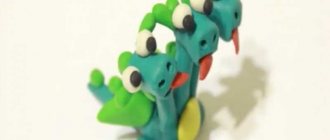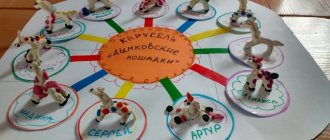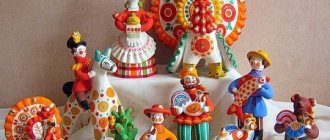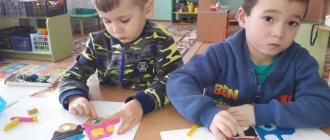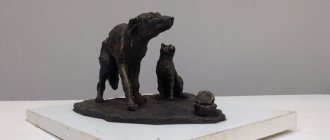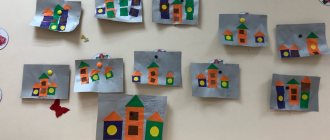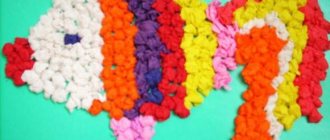Summary of a modeling lesson for the senior group
Summary of a modeling lesson in the senior group.
Topic: “Kinder toys”
Fefilova Irina Petrovna
Target:
Strengthen skills in working with plasticine, develop the ability to use waste material in modeling.
Educational areas:
cognitive development, artistic and aesthetic development, social and communicative development
Objectives: 1. Cognitive development.
Develop imagination and creativity.
2. Artistic and aesthetic development.
Develop the ability to conceive the content of your work and bring it to completion.
Strengthen the ability to use previously mastered sculpting methods, achieving expressiveness in the image of the intended animal. 3. Speech development.
Expand children's vocabulary, develop dialogical speech.
4. Social and communicative development.
Develop positive attitudes towards various types of creativity.
To develop children's communication and interaction with adults and peers. Preliminary work:
looking at pictures of animals.
Material:
multi-colored capsules from kinder surprises, plasticine, stacks, cardboard stands, boards for modeling for each child.
Progress: Educator:
Guys, do you like sweets?
What's your favorite treat? (children's answers). Educator:
If you love Kinder surprises, you probably have empty Kinder eggs somewhere in your house.
You can throw away this waste material, or you can look at it and figure out where you can use these capsules (children's answers). Educator:
If you fill Kinder containers with various fillings, for example: peas, buckwheat, rice, they will turn into a rattle for small children, or even into a musical instrument (the teacher shows a capsule filled with cereal).
Educator:
In such capsules it is also convenient to store various little things that can easily get lost: beads, beads, small buttons.
Educator:
There is another interesting and simple idea - string empty kinder eggs onto fishing line or wire.
This will make a wonderful garland; you can decorate your Christmas tree with it for the New Year. Single-color eggs can be painted with paints. If you draw funny faces on our kinder eggs, you will get charming emoticons, bees, and minions. Educator:
Or maybe some of you know the most well-known idea for colds and flu?
(the capsule is filled with pieces of garlic, holes are made in it and attached to a string). Educator:
You can also make a “snake” craft from Kinder eggs: insert one half into the other, using several capsules.
Advertisement 05
Educator:
Each Kinder egg can be turned into an animal.
How do you think? (you can paint an animal on an egg, you can sculpt it from plasticine). Educator:
Only the paints needed are not watercolors or gouache, but acrylic ones, because the capsules are plastic, and ordinary paints do not stick well to plastic.
The teacher leads the children to the fact that Kinder eggs can be used in modeling. Educator:
Today we will turn our capsules into animals using plasticine.
Let's look at a kinder egg and figure out what kind of animal we can turn it into. For example, let's add eyes, a nose, long ears, four legs - and before us is a cheerful...who? (bunny). Educator:
What other animals can we sculpt?
(children's answers). Each animal has its own distinctive characteristics. Riddles will help us remember them: Good-natured, businesslike, Covered with needles... Can you hear the patter of nimble legs? This is our friend... (hedgehog) This animal is somehow strange: Its neck is like an arrow from a crane. To reach the herbs with your mouth, it will fold in half... (giraffe) Cunning cheat, Red head, Fluffy tail - beauty! And her name is... (fox). What a miracle! What a miracle! A dish on top, a dish below! A miracle walks along the road, its head sticks out and its legs stick out. (Turtle) A log is floating in the river, It really wants to eat. The evil, green one opened his toothy mouth... (Crocodile) Don’t touch him with your hand! He has a mane, but he is not a horse. There are no hooves, but there are fangs and claws on the paws. (Lion) Educator:
Guys, choose a capsule of any color and turn it into an animal. During the work, the teacher guides the children’s actions, if they experience difficulties, and helps with advice. Children place their works on cardboard and put them on display.
GCD summary. Modeling “Hedgehog” in the senior group of preschool educational institutions
The plan is a summary of the GCD in the senior compensation group. Topic: “Hedgehog” (plasticine modeling)
Author: Tsutserova Natalya Alexandrovna.
My work may be useful for kindergarten teachers and additional education teachers. Integration of educational areas : cognitive, speech, communication, artistic - aesthetic, physical. Goal: teach children to sculpt wild animals. Objectives: Cognitive development: • Develop interest in wild animals. • Expand knowledge about hedgehogs: appearance, lifestyle, nutrition. • Learn to understand the relationships in nature. • Respect for nature. Social and communicative development: • Clarify knowledge about the rules of behavior in nature. • Develop independence when performing work. • Develop the ability to work together with peers. Speech development: • Develop the ability to perceive fiction. • Develop sound and phonemic hearing. • Develop connected, interactive speech. • Develop the ability to answer questions with complete answers. • Practice onomatopoeia. Artistic and aesthetic development: • Teach children to sculpt a hedgehog, conveying the characteristic features of its appearance, and complement the image. • Develop an interest in working with plasticine. • Develop an aesthetic attitude towards the surrounding world. • Develop fantasy and imagination. Physical development • Develop fine motor skills of the hands. • Prevent children from becoming tired. Methods and techniques. • Gaming: didactic, verbal games.
• Practical: examining a sample, doing the work independently. • Visual: showing and explaining the work • Verbal: situational conversation, questions, explanations from the teacher. Materials: plasticine (beige, brown, gray), napkins, seeds. Progress of the lesson.
- Guys, let's play!
The game is called "Football". Children throw a ball to each other and name forest animals. Surprise moment: - Look, guys, someone brought a basket. I wonder what's there? (teacher raises handkerchief) - Note! (Reading) Angry touchy lives in the wilderness of the forest There are a lot of needles, But not one thread. (Hedgehog)
- Right. Look what a beautiful hedgehog! “Once, a hedgehog I knew told me the following story. When he was very small, he had blind eyes, deaf ears, and no needles at all. The hedgehog's mother would not let him go far from her until good, strong needles appeared. The hedgehog has a lot of needles, which are renewed every 3 years. He has 36 teeth. When hunting, he relies only on hearing and smell, as his eyesight is very poor. — What do you think hedgehogs eat? — Hedgehogs feed on insects, small birds, bird eggs, lizards, berries, snakes, frogs. — Do hedgehogs have enemies? — Of course, there are eagle owls, large owls, hawks, and foxes. — What do hedgehogs need needles for? - Yes, guys, hedgehogs need needles for protection. The hedgehog is capable of curling up into a tight ball, with its spines exposed; it hisses and twitches strongly, jumping up if you touch it. -Let's try to become hedgehogs. Breathing improvisation “Hedgehog” - The hedgehog wrinkles his nose, bites his lower lip, and pronounces the sound “fff”. — The hedgehog wrinkles his eyebrows and pronounces the sound combination “puff-puff-puff.” - The hedgehog puffs out his cheeks, then exhales with the sound “pu-u-u” - The hedgehog is tired, exhale through his throat with the sound “ha-a-a” Well done! - Guys, the hedgehog hunts in the summer and breeds offspring. What does he do in winter? - Yes. The hedgehog hibernates. Hibernation lasts 128 days. When he wakes up, the hedgehog is very hungry, so he spends several days searching for food. — How to understand the proverb: “The hedgehog is the nurse of the forest and the ship of the edges.” - Ri. The poem “He’s like a Christmas tree” He’s like a Christmas tree, Covered in needles, Bravely catching scary snakes. And although he is very prickly, don’t you dare offend him. He lives in the forest. But the funny hedgehog also enters the gardens. — Hedgehogs live in the forest. Even in our forests of the Samara region. -Why can’t you take a hedgehog home? - Yes you are right. It really shouldn't be taken home as it is a wild animal and should live in the forest. Hedgehogs are also nocturnal animals. If you take him home, he simply won’t let you rest at night, as he stomps so much. And at home he can die. — If you can’t take a hedgehog home, what can you do? -Made from plasticine. - First, we need to stretch our fingers. Physical education Hedgehog, prickly hedgehog The fingers of two hands are clasped together.
Show the needles.
Movement of the brushes to the right, left.
Here they are, here they are, here they are.
We straighten our fingers, clasp our hands.
Hedgehog, prickly hedgehog
Put them in a castle
Hide your needles. Once, and there are no needles.
Doing practical work:
1. Warm the plasticine with your palms 2. Roll out the body of the hedgehog. From one edge we make the shape of a muzzle, a sharp nose.
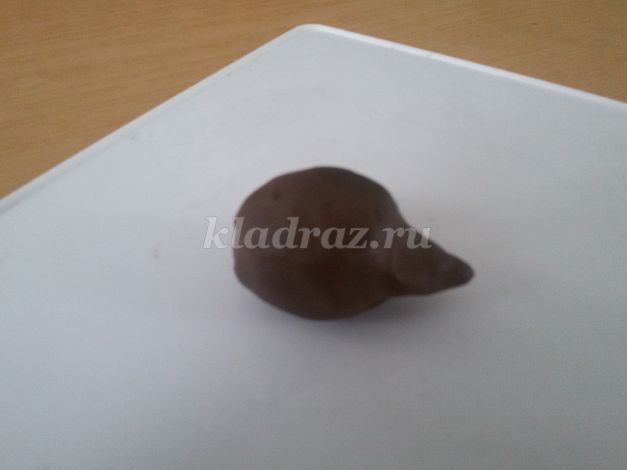
3. From the side of the muzzle, we begin to insert the seeds with the sharp side into the plasticine.
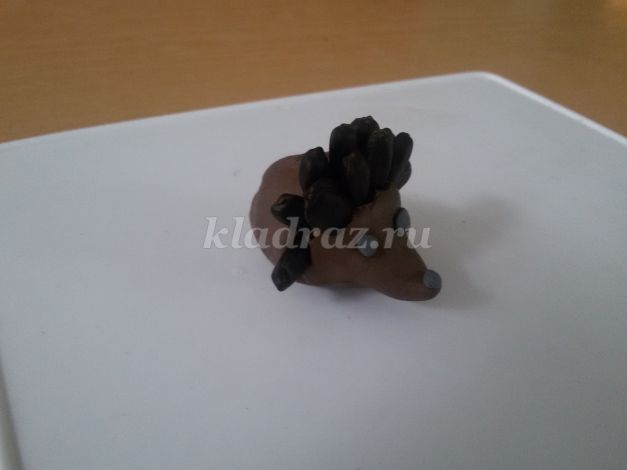
4. When you reach the end of the hedgehog's back. Make sure that the plasticine is not visible from behind.
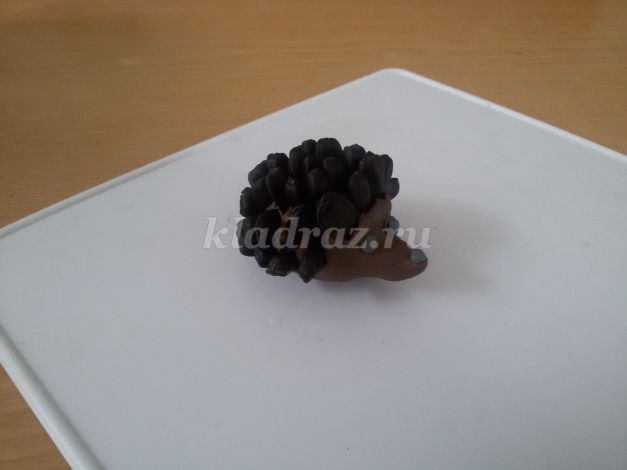
5. Make eyes and nose.
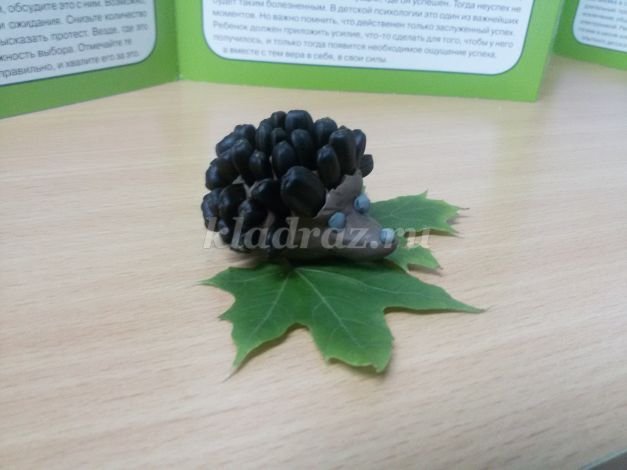
Reflection. - What wonderful work you have done! - Let's look at them.
We recommend watching:
Summary of GCD in the senior group. A journey through Chukovsky's fairy tales. Notes on direct educational activities in the senior group for children with mental retardation. Notes on cognitive and research activities in the senior group. Notes on educational activities in the senior group on the topic “How to see the air.”
Similar articles:
Summary of a safety lesson in the senior group: Safety in nature
Lesson on basic safety in the senior group. Topic: Rules of conduct while walking
Life safety tasks for children 5-7 years old
Lesson 35. Ladybug (Modeling from plasticine in combination with natural material)
Program content. Continue to teach children to combine natural material (half a walnut shell) with plasticine in crafts. Learn to apply plasticine to a semicircular object; independently bring the product to the intended image; give the image expressiveness (the ladybug crawls, eats, looks, etc.). Strengthen the ability to understand and analyze the content of a nursery rhyme.
Material. Halves of walnut shells, plasticine, stacks, cardboard stands, boards (for each child).
Progress of the lesson
Read D. Rozalieva’s poem “Robot” to the children:
Robot - robot - hard worker He has a craving for movement. He's on the battery all day - And he's not too lazy to walk.
Consider a toy robot with your children and offer to sculpt robots from plasticine. Warn the guys that they will have to work with cut pieces of plasticine. Under no circumstances should they be rolled out. Explain the sequence of work: you need to take a block of new plasticine and cut it into several parts using a stack. The largest part is the torso; small rectangle - head; 2 short rectangles – hands; 2 long rectangles – legs; 2 small rectangles - feet-stands. The robot is then assembled from the cut parts. His face is shaped using small plasticine balls.
Lesson 36. Fish (Applying plasticine to the surface)
Program content. Continue teaching children to apply a thin layer of plasticine onto a silhouette of an object cut out of cardboard. Learn to attach small coins to plasticine, depicting fish scales. Develop accuracy when working with plasticine. Learn to correlate the words of the poem and expressive movements of the hands and fingers.
Material. Silhouettes of fish cut out of cardboard, plasticine, small coins (or small flat multi-colored buttons), stacks, a modeling board (for each child).
Progress of the lesson
Read the nursery rhyme to the children:
Ladybug, Black Head, Fly to the sky, Bring us bread, Black and white, Just not burnt.
Ask the children: “What is the ladybug asked for in this nursery rhyme?”
Invite the children to make a ladybug from half a walnut shell. Explain the sequence of work: the inside of the shell is filled with plasticine of any color, and the top is coated with red plasticine. Black plasticine is applied to the front of the shell - this is the head. Six legs are molded from thin sausages and attached to the lower part of the ladybug's body. On the back there are small black plasticine balls (dots). The ladybug is ready.
The children get to work.
Progress of the lesson
Read N. Matveeva’s poem “The Girl and Plasticine” to the children:
I sculpt from plasticine (Plasticine is softer than clay) I sculpt from plasticine Dolls, clowns, dogs...
Ask the children: “What else can be sculpted from plasticine?”
Look at the white Kinder Surprise capsule with your children. What animal can she be turned into? For example, let's add eyes, a nose, long ears, four legs - and we have a cheerful bunny. Think with your children what other animals the capsules can be turned into (dog, giraffe, cow, parrot, penguin, crocodile, frog, mouse, etc.).
Invite each child to choose a capsule of any color and turn it into an animal. During the work, guide the children’s actions if they are experiencing difficulties; help with advice.
At the end of the lesson, the guys talk about their work - who they sculpted and why.
